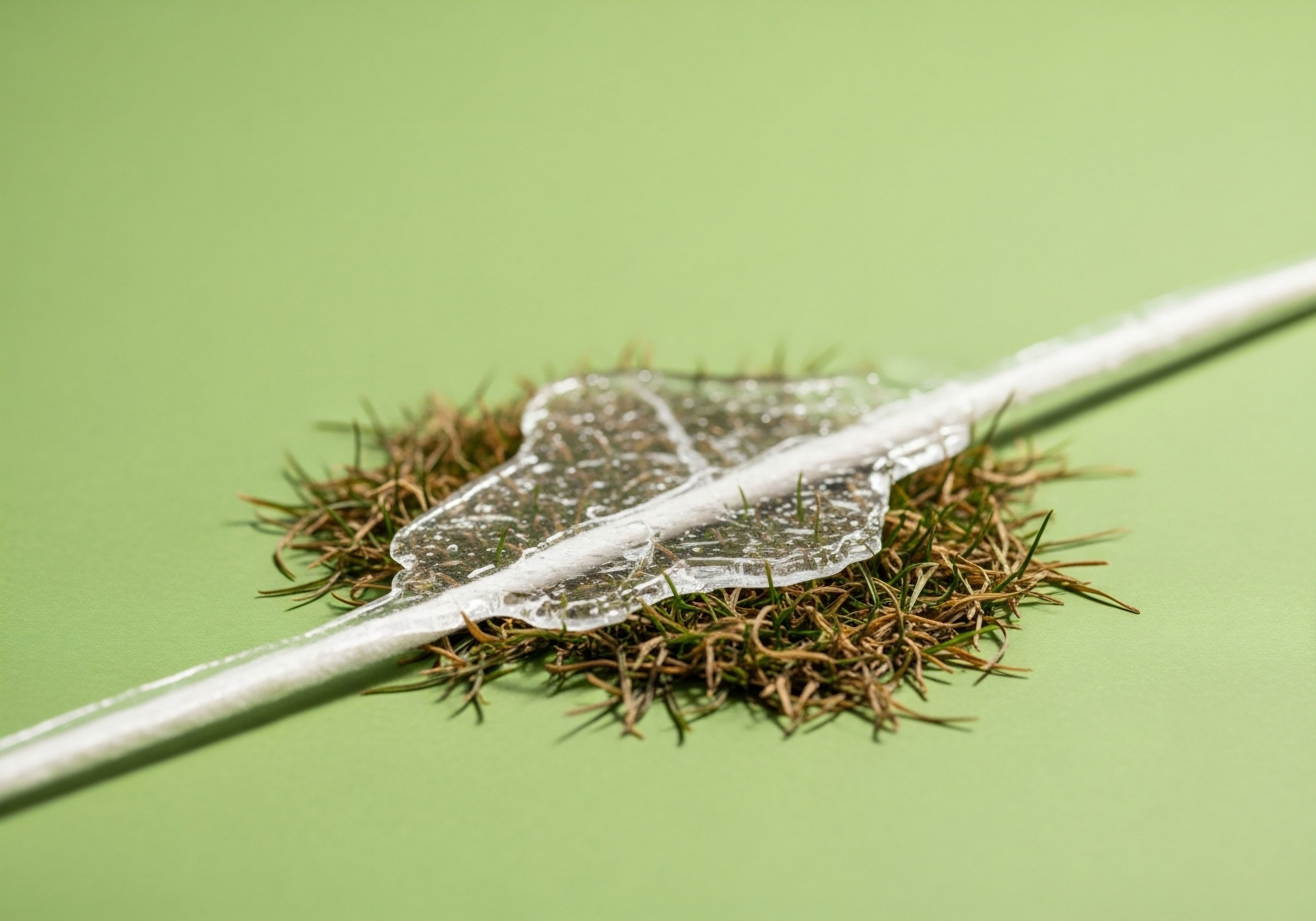

Fundamentals
Many individuals experience a subtle, yet persistent, sense that their vitality is diminishing. Perhaps a noticeable dip in energy levels, a reduction in physical resilience, or a shift in reproductive health becomes apparent. These changes, often dismissed as inevitable aspects of aging or daily stress, can signal a deeper biological imbalance.
The human body operates as an exquisitely synchronized system, where internal messaging services, known as hormones, orchestrate countless functions. When these messages become distorted or their pathways obstructed, the effects can ripple across multiple systems, including those governing male reproductive capacity.
The modern environment presents a complex array of challenges to this delicate internal balance. We are surrounded by substances that, while seemingly innocuous in isolation, can collectively interfere with our endocrine system. These are known as endocrine-disrupting chemicals (EDCs). They are present in everyday items, from plastics and pesticides to personal care products and even the air we breathe. Their pervasive presence means that exposure is not a choice, but a constant reality for many.
The impact of these environmental agents on male fertility is a growing concern. For years, discussions around reproductive challenges often centered on female factors. However, contemporary understanding recognizes the significant contribution of male reproductive health to conception rates. A decline in male fertility, characterized by reduced sperm count, impaired motility, or altered morphology, is increasingly linked to these external chemical influences.
Environmental agents can subtly disrupt the body’s hormonal messaging, affecting male reproductive health.
The male reproductive system, particularly the testes, is remarkably sensitive to external stressors. The production of sperm, a process known as spermatogenesis, requires a precisely regulated hormonal environment. This regulation is governed by the hypothalamic-pituitary-gonadal (HPG) axis, a sophisticated feedback loop involving the brain and the testes.
The hypothalamus releases gonadotropin-releasing hormone (GnRH), which prompts the pituitary gland to secrete luteinizing hormone (LH) and follicle-stimulating hormone (FSH). LH stimulates Leydig cells in the testes to produce testosterone, while FSH acts on Sertoli cells, which support sperm development.
Environmental toxins can interfere with this axis at various points. Some EDCs mimic natural hormones, tricking the body’s receptors. Others block hormone action or alter their synthesis and metabolism. This interference can lead to hormonal imbalances, directly impairing the intricate process of sperm production and maturation. Understanding these foundational biological principles provides a basis for considering how targeted interventions might support the body’s resilience against such external pressures.


Intermediate
When facing concerns about male reproductive health, particularly when environmental exposures are a suspected influence, a precise understanding of therapeutic strategies becomes paramount. Hormonal optimization protocols are not merely about raising a single hormone level; they represent a careful recalibration of the body’s internal communication network. The aim is to restore a physiological environment conducive to robust reproductive function, thereby helping the system better contend with external disruptions.

Targeted Endocrine System Support
The primary goal of many male fertility protocols involves optimizing the delicate balance of the HPG axis. This system, acting like a sophisticated thermostat, adjusts hormone production based on circulating levels. When environmental toxins disrupt this balance, specific interventions can help re-establish proper signaling.
- Gonadorelin ∞ This synthetic version of gonadotropin-releasing hormone (GnRH) can be administered in a pulsatile manner. Its purpose is to mimic the brain’s natural rhythm, stimulating the pituitary gland to release both LH and FSH. This approach is particularly useful in cases of hypogonadotropic hypogonadism, where the brain’s signaling to the testes is insufficient. By re-establishing this upstream signal, the body’s inherent capacity for testosterone production and spermatogenesis can be reactivated.
- Selective Estrogen Receptor Modulators (SERMs) ∞ Compounds such as Clomiphene Citrate and Tamoxifen work by blocking estrogen receptors in the hypothalamus and pituitary. Estrogen, even in men, exerts a negative feedback on the HPG axis, signaling the brain to reduce LH and FSH output. By blocking this feedback, SERMs effectively “trick” the brain into increasing its output of LH and FSH, leading to a rise in endogenous testosterone and improved testicular function. This can be a valuable strategy when environmental toxins lead to an unfavorable testosterone-to-estrogen ratio.
- Aromatase Inhibitors (AIs) ∞ Medications like Anastrozole prevent the conversion of testosterone into estrogen. While some estrogen is necessary for male health, excessive levels can suppress the HPG axis and directly impair spermatogenesis. By reducing estrogen levels, AIs help maintain a more favorable hormonal environment, supporting both testosterone production and sperm quality. This can be particularly relevant if certain environmental toxins promote increased estrogenic activity or conversion.

Addressing Exogenous Testosterone Effects
A common scenario requiring careful hormonal management involves men who have previously used exogenous testosterone, often for symptoms of low energy or muscle support. While beneficial for systemic testosterone levels, external testosterone administration significantly suppresses the body’s natural production of LH and FSH, leading to a cessation of sperm production and testicular atrophy. This is a critical distinction ∞ direct testosterone replacement, while optimizing systemic testosterone, can induce infertility.
Hormonal interventions aim to restore the body’s natural signaling pathways, counteracting disruptions.
For men seeking to restore fertility after exogenous testosterone use, or those with primary hypogonadism, specific protocols are employed:
- Human Chorionic Gonadotropin (hCG) ∞ This compound acts as an analogue to LH, directly stimulating the Leydig cells in the testes to produce testosterone. When combined with SERMs or AIs, hCG helps maintain or restore intratesticular testosterone levels, which are essential for spermatogenesis, even while systemic testosterone levels might be managed. This helps to preserve testicular size and function.
- Testosterone Replacement Therapy (TRT) with Fertility Preservation ∞ For men who require TRT for symptom management but also desire fertility, a combined approach is often considered. This involves administering exogenous testosterone alongside agents like hCG or SERMs. The hCG helps to maintain testicular function and sperm production despite the negative feedback from the external testosterone. This strategy aims to balance systemic well-being with reproductive goals.
The table below summarizes key hormonal agents and their primary actions in male fertility protocols.
| Agent | Primary Action | Relevance to Fertility |
|---|---|---|
| Gonadorelin | Stimulates pituitary LH/FSH release | Restores upstream signaling for testosterone and sperm production |
| Clomiphene Citrate / Tamoxifen | Blocks estrogen feedback at hypothalamus/pituitary | Increases endogenous LH/FSH, raising testosterone and supporting spermatogenesis |
| Anastrozole | Inhibits testosterone-to-estrogen conversion | Optimizes testosterone:estrogen ratio, reduces HPG axis suppression |
| Human Chorionic Gonadotropin (hCG) | Mimics LH, stimulates Leydig cells | Maintains intratesticular testosterone, supports spermatogenesis |
These protocols represent a thoughtful approach to managing the male endocrine system. By understanding the specific mechanisms of action, clinicians can tailor interventions to support the body’s intrinsic capacity for health, even when confronted by environmental stressors. The goal is not merely to treat a symptom, but to recalibrate the underlying biological systems for sustained well-being and reproductive potential.


Academic
The interaction between environmental toxins and male reproductive physiology represents a complex interplay of molecular and cellular events. A deep exploration reveals how these exogenous compounds, particularly endocrine-disrupting chemicals (EDCs), can derail the intricate processes governing spermatogenesis and steroidogenesis. Understanding these mechanisms provides the scientific rationale for hormonal optimization protocols as a means of systemic resilience and targeted support.

Molecular Mechanisms of Toxin-Induced Damage
Environmental toxins exert their deleterious effects through various pathways, often converging on cellular stress responses and genomic integrity.

Oxidative Stress and DNA Damage
Many EDCs, including heavy metals like lead and cadmium, and certain pesticides, induce the generation of reactive oxygen species (ROS) within testicular cells. While ROS are natural byproducts of cellular metabolism, an imbalance between ROS production and antioxidant defenses leads to oxidative stress. This oxidative overload can damage cellular components, including lipids, proteins, and critically, DNA.
Sperm DNA is particularly vulnerable due to its highly condensed chromatin structure and limited repair mechanisms. DNA fragmentation within sperm can severely compromise fertility outcomes, leading to reduced fertilization rates, impaired embryonic development, and increased miscarriage risk. Hormonal optimization, by supporting overall cellular health and metabolic function, can indirectly bolster antioxidant defenses, creating a more robust cellular environment.

Endoplasmic Reticulum Stress and Apoptosis
Certain EDCs, such as Bisphenol A (BPA), are known to induce endoplasmic reticulum (ER) stress in testicular cells. The ER is a cellular organelle responsible for protein folding and modification. When misfolded proteins accumulate due to toxic insult, the ER initiates an unfolded protein response (UPR).
Prolonged or severe ER stress can trigger programmed cell death, or apoptosis, in testicular cells, including spermatogonia and Sertoli cells. This cellular demise directly reduces the pool of cells available for sperm production, impairing spermatogenesis.

Disruption of Steroidogenesis
Leydig cells, situated within the testicular interstitium, are responsible for testosterone synthesis. This process, known as steroidogenesis, involves a series of enzymatic conversions starting from cholesterol. EDCs can interfere with this pathway by inhibiting the activity of key enzymes, such as P450scc (cholesterol side-chain cleavage enzyme), which is the rate-limiting step in testosterone production.
Heavy metals and phthalates, for instance, have been shown to directly impair Leydig cell function, leading to reduced testosterone synthesis. A compromised testosterone level within the testes directly impacts spermatogenesis, as high intratesticular testosterone is essential for sperm maturation.

Hormonal Protocols as Systemic Modulators
Hormonal optimization protocols, while not directly detoxifying the body of environmental agents, can significantly modulate the physiological environment, thereby enhancing the body’s capacity to withstand and recover from toxin-induced damage.

Restoring HPG Axis Integrity
The HPG axis is the central regulatory system for male reproductive function. EDCs often disrupt this axis by mimicking or blocking hormone receptors, altering hormone synthesis, or influencing feedback loops. Protocols involving Gonadorelin, SERMs (Clomiphene Citrate, Tamoxifen), and Aromatase Inhibitors (Anastrozole) directly address these disruptions.
By stimulating endogenous LH and FSH release (Gonadorelin, SERMs) or by optimizing the testosterone-to-estrogen ratio (AIs), these interventions help to restore the physiological signaling necessary for Leydig cell and Sertoli cell function. A properly functioning HPG axis ensures adequate levels of intratesticular testosterone, which is critical for supporting germ cell development and maintaining the integrity of the seminiferous tubules.
For instance, if an EDC leads to increased aromatase activity and elevated estrogen, Anastrozole can counteract this by reducing estrogen conversion, thereby alleviating its negative feedback on the pituitary and hypothalamus. This allows for increased endogenous LH and FSH, promoting testicular testosterone production and mitigating the estrogen-induced suppression of spermatogenesis.

Direct Testicular Support and Cellular Resilience
The administration of Human Chorionic Gonadotropin (hCG) directly stimulates Leydig cells, leading to increased intratesticular testosterone levels. This is particularly relevant when environmental toxins have compromised Leydig cell function or when exogenous testosterone has suppressed natural production. By ensuring a robust local testosterone environment, hCG supports the energy demands and structural integrity required for spermatogenesis, potentially counteracting some of the cellular damage induced by toxins.
Consider the impact of toxins on Sertoli cells, which form the blood-testis barrier and provide nutritional support to developing sperm. FSH, stimulated by the HPG axis or directly administered, acts on Sertoli cells to promote their function. By optimizing FSH levels, hormonal protocols can enhance the supportive environment for germ cells, potentially improving their resilience against oxidative stress and other toxin-mediated insults.
Optimizing hormonal balance can enhance cellular resilience against environmental toxin damage.
The concept extends to broader metabolic health. Peptides like Sermorelin and Ipamorelin/CJC-1295, which stimulate growth hormone release, contribute to overall cellular repair, protein synthesis, and metabolic efficiency. While not direct antitoxins, a body with optimized metabolic function and cellular repair mechanisms is inherently better equipped to handle systemic stressors, including the burden of environmental toxins.
Similarly, Pentadeca Arginate (PDA), known for its tissue repair and anti-inflammatory properties, could theoretically support the recovery of testicular tissue damaged by chronic toxic exposure, though direct clinical evidence in this specific context requires further investigation.
The table below illustrates the potential interplay between environmental toxins, their mechanisms of action, and how specific hormonal interventions might offer counter-regulatory support.
| Environmental Toxin Type | Primary Mechanism of Damage | Relevant Hormonal Protocol Action | Potential Mitigating Effect |
|---|---|---|---|
| Phthalates, BPA | ER stress, Leydig cell dysfunction, altered steroidogenesis | SERMs, hCG, AIs | Restores HPG axis signaling, boosts intratesticular testosterone, balances estrogen |
| Heavy Metals (Lead, Cadmium) | Oxidative stress, DNA damage, Leydig cell toxicity | hCG, SERMs (indirect metabolic support) | Increases intratesticular testosterone for cellular repair, improves overall testicular function |
| Pesticides (DDT, Organophosphates) | HPG axis disruption, estrogenic effects, oxidative stress | SERMs, AIs, Gonadorelin | Counteracts estrogenic mimicry, re-establishes HPG axis rhythm, reduces negative feedback |
While hormonal optimization protocols do not eliminate environmental toxins from the body, they work by strengthening the body’s internal regulatory systems. By ensuring optimal hormonal signaling, supporting cellular integrity, and enhancing metabolic resilience, these protocols can help the male reproductive system better withstand, adapt to, and recover from the pervasive challenges posed by environmental chemical exposures. This systems-biology perspective offers a path toward reclaiming reproductive vitality in a world increasingly burdened by external stressors.

References
- Chao, H. H. Zhang, Y. Dong, P. Y. Gurunathan, S. & Zhang, X. F. (2023). Comprehensive review on the positive and negative effects of various important regulators on male spermatogenesis and fertility. Frontiers in Nutrition, 9, 1063510.
- La Maestra, S. & Marrocco, G. (2024). Environmental Factors as the Main Hormonal Disruptors of Male Fertility. International Journal of Environmental Research and Public Health, 21(4), 415.
- Perrotta, I. & Aquilano, K. (2023). The Impact of Endocrine-Disrupting Chemicals in Male Fertility ∞ Focus on the Action of Obesogens. International Journal of Molecular Sciences, 24(10), 8788.
- Pastuszak, A. W. & Lipshultz, L. I. (2016). Frontiers in hormone therapy for male infertility. Translational Andrology and Urology, 5(4), 573 ∞ 583.
- Campbell, K. J. Sullivan, J. F. & Lipshultz, L. I. (2021). Updated protocols for optimizing sperm recovery after steroid use. Archives of Stem Cell Therapy, 2(1), 8-11.

Reflection
Considering the intricate dance of hormones and the pervasive presence of environmental agents, one might pause to consider their own biological landscape. The information presented here is not merely a collection of facts; it is a framework for understanding the profound connection between our internal systems and the world around us. Your personal experience, those subtle shifts in well-being, are valuable indicators. They represent signals from your body, inviting a deeper inquiry into its operational state.
This knowledge serves as a starting point, a map to guide your exploration. Reclaiming vitality and optimizing function is a highly individualized endeavor. It necessitates a careful assessment of your unique biological markers, a thoughtful consideration of your lifestyle, and a partnership with clinical expertise.
The path toward hormonal balance and enhanced resilience is a personal one, often requiring precise, tailored interventions. This journey is about empowering yourself with understanding, enabling you to make informed choices that align with your deepest health aspirations.



